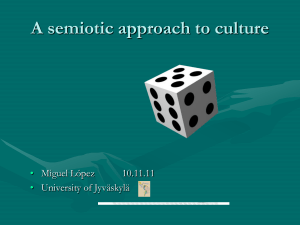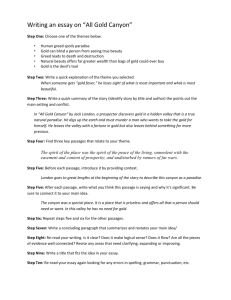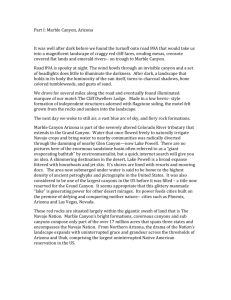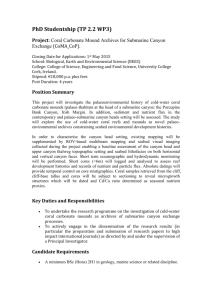Grand Canyon Exploration: Cárdenas's Account
advertisement
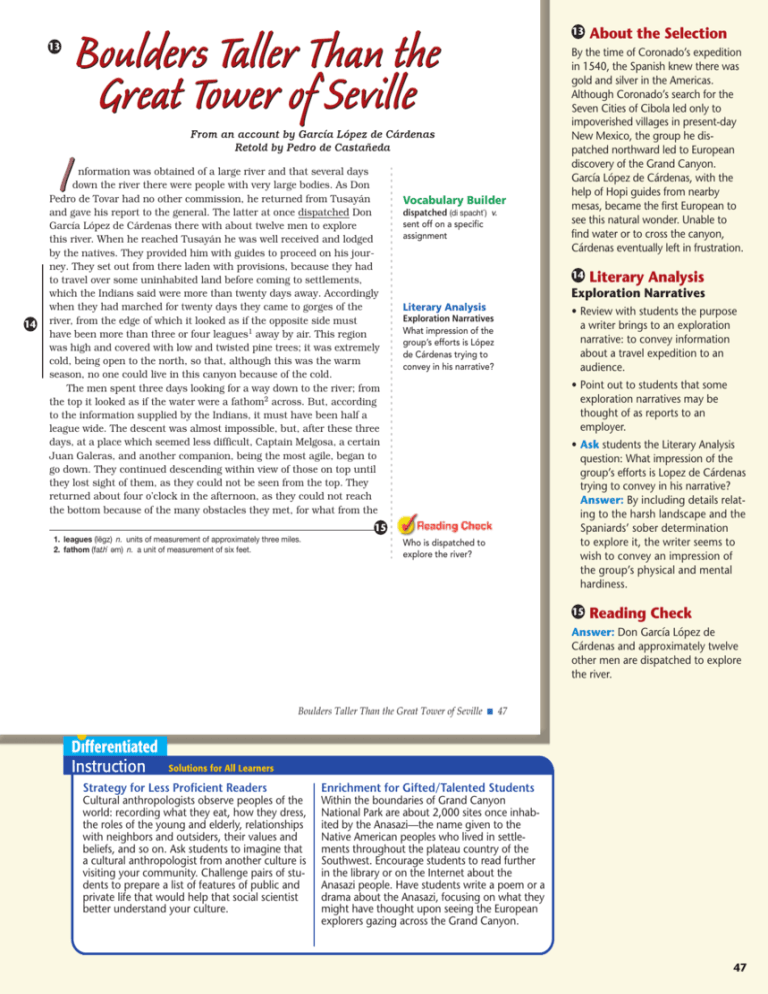
13 13 14 nformation was obtained of a large river and that several days down the river there were people with very large bodies. As Don Pedro de Tovar had no other commission, he returned from Tusayán and gave his report to the general. The latter at once dispatched Don García López de Cárdenas there with about twelve men to explore this river. When he reached Tusayán he was well received and lodged by the natives. They provided him with guides to proceed on his journey. They set out from there laden with provisions, because they had to travel over some uninhabited land before coming to settlements, which the Indians said were more than twenty days away. Accordingly when they had marched for twenty days they came to gorges of the river, from the edge of which it looked as if the opposite side must have been more than three or four leagues1 away by air. This region was high and covered with low and twisted pine trees; it was extremely cold, being open to the north, so that, although this was the warm season, no one could live in this canyon because of the cold. The men spent three days looking for a way down to the river; from the top it looked as if the water were a fathom2 across. But, according to the information supplied by the Indians, it must have been half a league wide. The descent was almost impossible, but, after these three days, at a place which seemed less difficult, Captain Melgosa, a certain Juan Galeras, and another companion, being the most agile, began to go down. They continued descending within view of those on top until they lost sight of them, as they could not be seen from the top. They returned about four o’clock in the afternoon, as they could not reach the bottom because of the many obstacles they met, for what from the Vocabulary Builder dispatched (di spa£t«) v. sent off on a specific assignment By the time of Coronado’s expedition in 1540, the Spanish knew there was gold and silver in the Americas. Although Coronado’s search for the Seven Cities of Cibola led only to impoverished villages in present-day New Mexico, the group he dispatched northward led to European discovery of the Grand Canyon. García López de Cárdenas, with the help of Hopi guides from nearby mesas, became the first European to see this natural wonder. Unable to find water or to cross the canyon, Cárdenas eventually left in frustration. 14 Literary Analysis Exploration Narratives Literary Analysis Exploration Narratives What impression of the group’s efforts is López de Cárdenas trying to convey in his narrative? • Review with students the purpose a writer brings to an exploration narrative: to convey information about a travel expedition to an audience. • Point out to students that some exploration narratives may be thought of as reports to an employer. 15 1. leagues (lègz) n. units of measurement of approximately three miles. 2. fathom (faª« ßm) n. a unit of measurement of six feet. About the Selection Who is dispatched to explore the river? • Ask students the Literary Analysis question: What impression of the group’s efforts is Lopez de Cárdenas trying to convey in his narrative? Answer: By including details relating to the harsh landscape and the Spaniards’ sober determination to explore it, the writer seems to wish to convey an impression of the group’s physical and mental hardiness. 15 Reading Check Answer: Don García López de Cárdenas and approximately twelve other men are dispatched to explore the river. Boulders Taller Than the Great Tower of Seville ■ 47 Strategy for Less Proficient Readers Enrichment for Gifted/Talented Students Cultural anthropologists observe peoples of the world: recording what they eat, how they dress, the roles of the young and elderly, relationships with neighbors and outsiders, their values and beliefs, and so on. Ask students to imagine that a cultural anthropologist from another culture is visiting your community. Challenge pairs of students to prepare a list of features of public and private life that would help that social scientist better understand your culture. Within the boundaries of Grand Canyon National Park are about 2,000 sites once inhabited by the Anasazi—the name given to the Native American peoples who lived in settlements throughout the plateau country of the Southwest. Encourage students to read further in the library or on the Internet about the Anasazi people. Have students write a poem or a drama about the Anasazi, focusing on what they might have thought upon seeing the European explorers gazing across the Grand Canyon. 47 16 Reading Strategy Recognizing Signal Words • Ask students the Reading Strategy question: What change do the words “up to that time” signal? Answer: This phrase signals a change in the course of the journey. Monitor Progress: Ask a student volunteer to explain the three most common types of relationships between ideas that are indicated by signal words. Answer: Signal words most commonly indicate time relationships, connections of causality, and contrasts. Answers 1. Students who have never visited the canyon may be surprised that the Spaniards were unable to descend. 2. (a) They wanted them to serve as guides. (b) The Native Americans may have been afraid of the Spaniards. 3. (a) They are afraid that the Native Americans will flee in terror and leave them stranded—and that other Native Americans will then avoid them. (b) They believe the Spaniards have the power to wish them dead. 4. (a) They are expecting to explore the Colorado River. (b) Possible reasons include meeting and learning about the people reputed to live near the river or exploring the river’s possible use as a means of travel. 5. (a) It appears to be about six feet wide. (b) They are viewing the river from an extraordinary height. 6. The account might contain detailed descriptions of the canyon’s impressive size and beauty in order to convince financial backers that exploration of the canyon could bring them fame, glory, and riches. For additional information about Alvar Núñez Cabeza de Vaca or García López de Cardenas, have students type in the Web Code, then select C or L from the alphabet, and then select Alvar Núñez Cabeza de Vaca or García López de Cardenas. 48 16 top seemed easy, was not so, on the contrary, it was rough and difficult. They said that they had gone down one-third of the distance and that, from the point they had reached, the river seemed very large, and that, from what they saw, the width given by the Indians was correct. From the top they could make out, apart from the canyon, some small boulders which seemed to be as high as a man. Those who went down and who reached them swore that they were taller than the great tower of Seville.3 The party did not continue farther up the canyon of the river because of the lack of water. Up to that time they had gone one or two leagues inland in search of water every afternoon. When they had traveled four additional days the guides said that it was impossible to go on because no water would be found for three or four days, that when they themselves traveled through that land they took along women who brought water in gourds, that in those trips they buried the gourds of water for the return trip, and that they traveled in one day a distance that took us two days. This was the Tizón river, much closer to its source than where Melchior Díaz and his men had crossed it. These Indians were of the same type, as it appeared later. From there Cárdenas and his men turned back, as that trip brought no other results. Reading Strategy Recognizing Signal Words What change do the words “up to that time” signal? 3. great tower of Seville The Giralda, the tower on the Cathedral of Seville in Spain, rises above the cathedral more than twice its height. Critical Reading 1. Respond: How does López de Cárdenas’s description compare with your knowledge of the Grand Canyon? 2. (a) Recall: Why do the Spaniards in “A Journey Through Texas” order the Native Americans to travel with them? (b) Infer: Why do the Native Americans obey the orders? 3. (a) Recall: In “A Journey Through Texas,” why do the Spaniards become fearful when the Native Americans in their company die? (b) Draw Conclusions: What do the Native Americans believe is the cause of the sickness? 4. (a) Recall: What are López de Cárdenas and his men expecting to explore? (b) Infer: Why does Coronado send the group on this mission? 5. (a) Recall: How wide does the river appear from the edge? (b) Hypothesize: Why does the river seem narrow from above? 6. Extend: How might these accounts have been different if they had been written to secure further funding? 48 ■ Beginnings–1750 For: More about Alvar Núñez Cabeza de Vaca and García López de Cárdenas Visit: www.PHSchool.com Web Code: ere-9103


